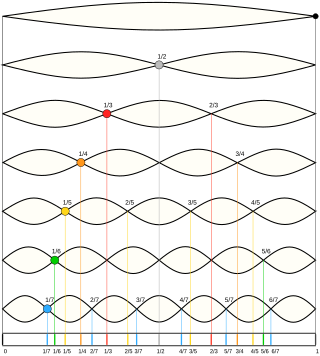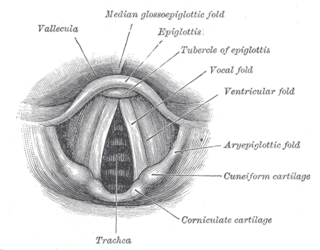Related Research Articles

The human voice consists of sound made by a human being using the vocal tract, including talking, singing, laughing, crying, screaming, shouting, humming or yelling. The human voice frequency is specifically a part of human sound production in which the vocal folds are the primary sound source.

In physics, acoustics, and telecommunications, a harmonic is a sinusoidal wave with a frequency that is a positive integer multiple of the fundamental frequency of a periodic signal. The fundamental frequency is also called the 1st harmonic; the other harmonics are known as higher harmonics. As all harmonics are periodic at the fundamental frequency, the sum of harmonics is also periodic at that frequency. The set of harmonics forms a harmonic series.

An overtone is any resonant frequency above the fundamental frequency of a sound. In other words, overtones are all pitches higher than the lowest pitch within an individual sound; the fundamental is the lowest pitch. While the fundamental is usually heard most prominently, overtones are actually present in any pitch except a true sine wave. The relative volume or amplitude of various overtone partials is one of the key identifying features of timbre, or the individual characteristic of a sound.

The tin whistle, also known as the penny whistle, is a simple six-holed woodwind instrument. It is a type of fipple flute, putting it in the same class as the recorder, Native American flute, and other woodwind instruments that meet such criteria. A tin whistle player is called a whistler. The tin whistle is closely associated with Irish traditional music and Celtic music. Other names for the instrument are the flageolet, English flageolet, Scottish penny whistle, tin flageolet, or Irish whistle.

In music, timbre, also known as tone color or tone quality, is the perceived sound quality of a musical note, sound or tone. Timbre distinguishes different types of sound production, such as choir voices and musical instruments. It also enables listeners to distinguish different instruments in the same category.

Singing is the act of creating musical sounds with the voice. A person whose profession is singing is called a singer, artiste or vocalist. Singers perform music that can be sung with or without accompaniment by musical instruments. Singing is often done in an ensemble of musicians, such as a choir. Singers may perform as soloists or accompanied by anything from a single instrument up to a symphony orchestra or big band. Many styles of singing exist throughout the world.
Falsetto is the vocal register occupying the frequency range just above the modal voice register and overlapping with it by approximately one octave.
Overblowing is the manipulation of supplied air through a wind instrument that causes the sounded pitch to jump to a higher one without a fingering change or the operation of a slide. Overblowing may involve a change in the air pressure, in the point at which the air is directed, or in the resonance characteristics of the chamber formed by the mouth and throat of the player.

Indigenous music of North America, which includes American Indian music or Native American music, is the music that is used, created or performed by Indigenous peoples of North America, including Native Americans in the United States and Aboriginal peoples in Canada, Indigenous peoples of Mexico, and other North American countries—especially traditional tribal music, such as Pueblo music and Inuit music. In addition to the traditional music of the Native American groups, there now exist pan-Indianism and intertribal genres as well as distinct Native American subgenres of popular music including: rock, blues, hip hop, classical, film music, and reggae, as well as unique popular styles like chicken scratch and New Mexico music.
Head voice is a term used within vocal music. The use of this term varies widely within vocal pedagogical circles and there is currently no one consistent opinion among vocal music professionals in regard to this term. Head voice can be used in relation to the following:

An organ stop is a component of a pipe organ that admits pressurized air to a set of organ pipes. Its name comes from the fact that stops can be used selectively by the organist; each can be "on", or "off".
Vocal range is the range of pitches that a human voice can phonate. A common application is within the context of singing, where it is used as a defining characteristic for classifying singing voices into voice types. It is also a topic of study within linguistics, phonetics, and speech-language pathology, particularly in relation to the study of tonal languages and certain types of vocal disorders, although it has little practical application in terms of speech.
A multiphonic is an extended technique on a monophonic musical instrument in which several notes are produced at once. This includes wind, reed, and brass instruments, as well as the human voice. Multiphonic-like sounds on string instruments, both bowed and hammered, have also been called multiphonics, for lack of better terminology and scarcity of research.

In music, the range, or chromatic range, of a musical instrument is the distance from the lowest to the highest pitch it can play. For a singing voice, the equivalent is vocal range. The range of a musical part is the distance between its lowest and highest note.

A vocal register is a range of tones in the human voice produced by a particular vibratory pattern of the vocal folds. These registers include modal voice, vocal fry, falsetto, and the whistle register. Registers originate in laryngeal function. They occur because the vocal folds are capable of producing several different vibratory patterns. Each of these vibratory patterns appears within a particular range of pitches and produces certain characteristic sounds.
The guan is a Chinese double reed wind instrument. The northern Chinese version is called guanzi or bili and the Cantonese version is called houguan. It is classified as a bamboo instrument in the Ba Yin system. Unlike other instruments in the double-reed family of woodwinds which mostly have conical bores, such as the Chinese suona or the Western oboe, the guan has a cylindrical bore, giving its distinctive mellow, yet piercing buzz-like timbre.
Chest voice is a term used within vocal music. The use of this term varies widely within vocal pedagogical circles and there is currently no one consistent opinion among vocal music professionals in regard to this term. Chest voice can be used in relation to the following:
In music, the undertone series or subharmonic series is a sequence of notes that results from inverting the intervals of the overtone series. While overtones naturally occur with the physical production of music on instruments, undertones must be produced in unusual ways. While the overtone series is based upon arithmetic multiplication of frequencies, resulting in a harmonic series, the undertone series is based on arithmetic division.

Vocal pedagogy is the study of the art and science of voice instruction. It is used in the teaching of singing and assists in defining what singing is, how singing works, and how proper singing technique is accomplished.
Vocal resonance may be defined as "the process by which the basic product of phonation is enhanced in timbre and/or intensity by the air-filled cavities through which it passes on its way to the outside air." Throughout the vocal literature, various terms related to resonation are used, including: amplification, filtering, enrichment, enlargement, improvement, intensification, and prolongation. Acoustic authorities would question many of these terms from a strictly scientific perspective. However, the main point to be drawn from these terms by a singer or speaker is that the result of resonation is to make a better sound, or at least suitable to a certain esthetical and practical domain.
References
Notes
- ↑ Describing audio frequencies in terms of vertical pitch space is an example of a conceptual metaphor, one that is not a cultural universal. [2]
Citations
- 1 2 Large, John (February–March 1972). "Towards an Integrated Physiologic-Acoustic Theory of Vocal Registers". The NATS Bulletin. 28: 30–35.
- ↑ Zbikowski 2002, 66–68.
- 1 2 McKinney, James (1994). The Diagnosis and Correction of Vocal Faults. Genovex Music Group. ISBN 978-1-56593-940-0.
Bibliography
- Zbikowski, Lawrence M. 2002. Conceptualizing Music: Cognitive Structure, Theory, and Analysis. American Musicological Society Studies in Music Series, gen. ed. Lawrence F. Bernstein. Oxford: Oxford University Press. ISBN 978-0-19-514023-1 (hbk).